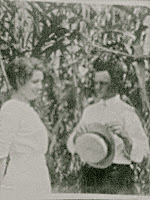While digging through the photograph albums for old camping pictures, I found these of
much earlier days.

Long ago styles and long ago pleasures; it appears to be so peaceful. The worst part of the day would be struggling into all those layers of clothes that the women wore! It has occured to me that it might take some careful planning if a suiter wished to sneak a kiss!

Some of this collection dates back to the early

1900s giving a glimps at life 100 years ago. Look at those hats, those long dresses and underskirts with high topped lace up shoes peeking out. Look at those tiny waists! And the guys with their suits and their hats cocked so jauntily. It must have been a good time in their lives; they all look carefree. In the overloaded swing, Mother is left, holding Byrd. I brlieve Ruth and far right, Paulina. Halton Cowling is seated on the steps, obviously used to the girls antics and ignoring them completly. He and Martha, the oldest girl, were the first to married and Martha guided her siblings through their early years. Throughout most of their marriage, their house was filled with visiting relatives.
What a pity the photography is usually of poor quality. These youngsters are Ruth's three boys, Billy, Ray,and Neil. Their father raised the boys after Ruth, their mother died.Martha raised their sister, Mary Lou.

Take a close look at that little red wagon. How about those large wheels of 100 years ago!
Left, brother Joe looks as though he is proposing to Kitty. A sweet picture and some tall stalks of cane.
 Mother is peeking around Paulina in
Mother is peeking around Paulina in
the photo of the canoing group. May be would-be suitors and possibly brother John for a chaporone
on a Sunday afternoon outing.
I think this is the house at Estaline that was one of the houses that boarded several teachers. It looks substantial enough to be still standing. I hope it is.

I have always believed these next pictures were taken at the "teacherage", as it was called. My impression has been that Mother and one sister, and friends were the ones here having silly fun.


Mother is on the extreme left, the one with the short hair. when that was a new style she was among the first to "bob" her hair. It appears on the photo on the left that she is getting paid back for the pounding she was giving some one in the left picture.
Such clowns! Trying to pretend they such nice young ladies! Mother is still

on the left. Perhaps it is her sister Paulina by herr side. Only a few of her pictures are labeled. Very few of the ones of my own family are, and that's another project for another day.
Shorter skirts became the new daring style but the ladies were not yet ready to give up their hats.

One could speculate upon what our styles will be in another 80 or 100 years. What comes off next? Not much, I hope, or there will be an epidemic of skin cancer.
There is an old saying, "The pendilum always swings back." Intreguing, huh?
Look closely at the picture hanging on the wall. That appears to be that large oil painting of the mountains and the elk. . I had no idea that she had painted that so early in her life, but I guess she was in her mid-twenties here, so it wasn't so early, after all. She began very early to spend her summers in Boulder,taking art lessons.

In the early '20s, when I think this picture was taken, it had become acceptable for women to wear pants when hiking. Mother, of course, with her bobbed hair and independant spirit, didn't hesitate to be among the first. Most of the remainder of her pictures preceeding her marriage in 1925, show her hiking in her beloved Colorado mountains, wearing her hiking pants, high, lace-up boots and that beaver hat. In this picture she is taking a rest stop with her sister Paulina.
It's just an old album but it's a window into life so long ago. One hundred years!

A wild flower that's also old..
Indian Blanket























